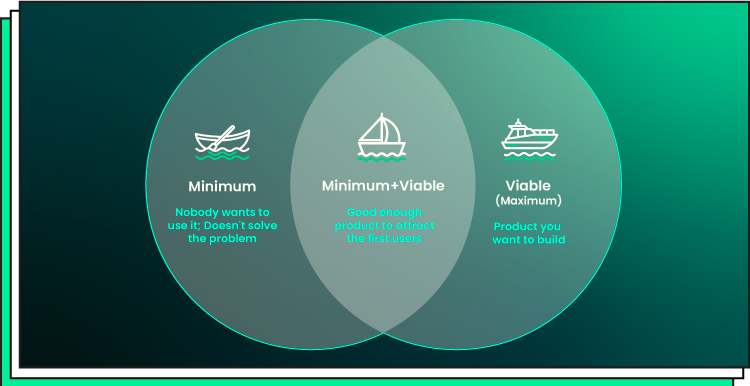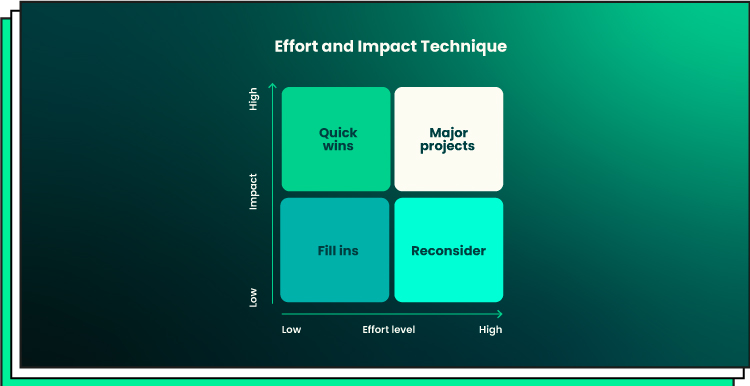MVP approach gains much popularity today as it helps businesses build high-demand solutions that meet client needs. However, MVP meaning in software development sometimes confuses those aiming to enter the market or launch a new startup. Today, we will figure it all out.
Starting a new business around a product or service is a brave decision. To get the best return, you should mitigate the risks and plan out the software development process meticulously. Many companies manage to do so. TechCrunch reports that at least 36 new tech unicorns have emerged in 2025 so far, many of which began as startups building a minimum viable product. Due to the effective growth strategy, they will manage to grow into popular and evergreen companies.
In this piece, we will discuss MVP meaning in the software context, outline the main benefits of MVP software development and best practices, and try to inspire you with a few successful MVP stories. Keep reading to decide if you should move to full-scale software development or protect your budget and start with a minimum viable product.
The MVP Meaning in Software Projects
Let’s answer the question “What is an MVP?” first. MVP stands for Minimum Viable Product. It is the test version of your product that contains only basic features and functions. MVP software development is created at the early project stages to test the viability of a product idea. After the minimum viable product is released, the development team collects user feedback and observes how people interact with the product. The insights gained from user feedback are then used to improve and enhance the solution, increasing its value. Also, by creating MVPs, you can attract the attention of the first users and focus on retaining them.
MVP vs. prototype: what’s the difference?
Now, we know what an MVP software development is. Let’s differentiate it from the related software engineering term.
When talking about MVP vs. prototype comparison, we’ll focus on the purpose. The goal of an MVP is to determine if a product is viable and what features best meet user needs, based on real customer feedback. Meanwhile, prototypes are built to visualize what is already planned out and give the team a basic understanding of what the solution will look like. Another difference between a prototype and a minimum viable product is that MVPs are accessed by end users who can interact with the product and provide valuable customer feedback. As a rule, a prototype is created only for internal use by the software development team.
How You Can Benefit from an MVP Approach
After discussing the MVP software meaning, it’s important to explore why so many startups and product teams choose this approach. MVPs aren’t just about launching faster; they help businesses validate a product idea early, test it in real conditions, reduce risks, and build solutions that truly meet user needs. This process of product validation is a key reason why the minimum viable product approach has become so popular in modern product development. Here are the main benefits a minimum viable product can bring:
Give your users what they want
Offering a good product does not always mean solving clients’ real problems. People won’t pay for products or services just because they look good; they want their pain points addressed. MVP software development gives you that opportunity. Instead of offering what you think they want, you can gather insights from early adopters, the users who are first to try your product, and figure out exactly what they truly need. Based on the data you collect from these early adopters, you can build features and elements that solve real problems and deliver real value.
Receive feedback
If you hear the voice of your clients, you increase the chances that your customers will stay with you for the long term. Receiving feedback about the MVP in software development is a great opportunity to communicate with your target audience and understand them better. When you look at your product from the real user’s perspective and put yourself in the client’s shoes, you’ll see whether the basic features truly meet their needs, what’s missing, and what your product’s strong sides are. This insight helps your development team prioritize improvements and build a solution that aligns with actual user expectations.
Save money and time
Launching large software development projects means investing a lot of money, time, and effort into the product. Sometimes, it can take years to bring your vision into reality. But not all businesses have so many resources to put at stake. This is why choosing MVP software development is a smarter decision; it allows you to create a product faster and more affordably by building just enough features to test your idea. You can then gather feedback, improve the product, and validate the concept before investing your entire budget, and use those insights to guide future development in the right direction.
Convince investors
The MVP approach can help you convince your investors that your business idea is worth supporting. It’s much harder to do this based on assumptions alone. But if you have real data showing that users like your software product, it becomes much easier to secure funding and grow it into a full-scale business. Building a minimum viable product (MVP) allows you to demonstrate the actual value your product brings to the market, highlighting the key attributes that resonate with users and investors. This helps you avoid common startup fail scenarios caused by launching products without validation.
Test your product idea before implementing it
Imagine you started software development, created a product, spent several months promoting it, and only a year later discovered that your solution wasn’t what users wanted. To prevent this from happening, you can start by building a minimum viable product. This approach allows you to validate your product idea early, spend less time and effort upfront, and quickly determine if there’s real demand. By releasing an MVP to initial users, you can gather valuable feedback and see how your product performs in real conditions. If the feedback is positive, you can confidently move forward with developing a full-scale app or website.
Scale easily
It’s safer for your budget to grow from a one-feature page or solution to a full-fledged product than to build all the features at once and later start removing the irrelevant or unused ones. A minimum viable product (MVP) helps you scale more efficiently, as you can add new features and functionality based on what your early customers need and provide feedback on. This way, you build a product that evolves with real user input, not assumptions.
So, as you can see, the MVP approach offers plenty of valuable benefits. It allows you not only to test your idea in real-world conditions but also to lay the foundation for building your business from the ground up.
If you need assistance with MVP development, Forbytes is here to help. With our expertise, we can do more than just implement your idea; we’ll work with you to shape it into a successful, scalable business.
How to Build a Strong MVP
The MVP approach can include many elements and features. As a dedicated software development partner, we’ll plan the process to align with your budget, expectations, and the overall product development cycle, ensuring your MVP fits seamlessly into long-term growth.
If you decide to create an MVP on your own, check some of the characteristics that will help you define what a good MVP is:
- Simplicity. After you discover the MVP meaning in software, you’ll see that it doesn’t contain all the features you want to see in your product. When creating an MVP, focus only on the main and basic functionality that will lie at the core of your software product.
- Purpose. MVPs should be developed with a purpose. For example, to define the perfect client, test the idea’s viability, prioritize the right features, etc.
- User needs. Like the final product, the MVP should meet user needs. By defining the needs, it will be easier for you to decide on the core functionality and features of your solution. When combined with market research, this approach ensures that you’re not only addressing what users want but also aligning your product with real market demand.
- Possibility of errors. No one says that an MVP should be perfect. It may and even should contain imperfections that might be discovered later. These imperfections will give you precious insights into possible improvements to the final product.
Ready to turn your MVP idea into a working product? Let Forbytes help you plan, build, and grow it into a scalable solution. Contact us today to get started!
MVP Development Tips Every Startup Should Know
Now you know the answer to the question, “What is MVP in software development?” Next, let’s move on to the MVP creation checklist. It’s pretty simple. First, conduct market research to identify the core features that will make your MVP a functional product. Then, plan your product development, choose the right tools and technologies for building the MVP, and finally, launch it. Expose your MVP to the target audience and collect data to continuously improve and enhance the solution.
When picking the most important features for your product, you may need to refer to the best MVP practices. These are:
- User journey mapping. In this practice, you will define the user goal and break it down into actionable steps (and substeps if needed). If the step cannot be skipped, it means that this feature or function is an important one and is worth adding to your MVP checklist. Combined with insights from market research, this method helps you prioritize features that align with both user needs and current market demand.
- Prioritization. Try to prioritize the features, numerically rating them from 1 to 3. The number 1 priority group will include the most critical core features, the ones the audience uses to complete their goal. Number 2 will stand for the moderate features, which increase user engagement or performance, or open extra revenue opportunities. Number 3 will cover the optional features that users do not expect but that make the app more attractive.
- Effort & impact technique. This method is very useful when exploring the MVP software meaning. It enables you to evaluate the features based on the effort needed to build them and the impact they have on the target audience and product. The analysis is done in a matrix, which helps you quickly sort the features out by importance. It’s a valuable tool in the MVP development process, helping teams focus on what truly matters for early-stage success. Check it out below:
3 Real MVP Startup Success Stories
Is MVP development for startups only? Not necessarily. For startups, it’s a good chance to test the success and viability of an idea without investing the whole budget into a full-scale product. Investing in a minimum viable product, though, does not mean that you are doomed to stay on the startup level forever. We can share many examples of MVP startups that successfully grew into big businesses. Let’s check a few of them:
Airbnb
Background: In 2007, Airbnb’s founders, Brian Chesky and Joe Gebbia, were struggling to pay rent in San Francisco. A design conference in town had left hotels overbooked, and the pair saw an opportunity: to offer air mattresses in their apartment to conference attendees, along with breakfast. That’s how the concept of “AirBed & Breakfast” was born.
MVP strategy: They quickly created a basic website to list their space and invited users to book a stay. This simple MVP allowed them to validate whether people would pay to stay in someone else’s home instead of a hotel. Their goal wasn’t to build a full-featured platform. They wanted to test the demand, gather early user feedback, and see if they could create a new category of short-term lodging. As a result, their successful MVP development contributed to implementing their product idea.
Lessons Learned:
-
A real-world, low-cost MVP can be enough to prove a big idea.
-
Solving a clear problem (lack of accommodation) with minimal tech can validate a concept.
-
Early user feedback shaped how the product evolved, emphasizing trust, safety, and ease of use in future versions.
Dropbox
Background: When Drew Houston founded Dropbox in 2007, cloud storage wasn’t yet mainstream. He had built a prototype that allowed users to sync files across devices, but building the infrastructure and interface for public use would be costly and time-consuming.
MVP strategy: Instead of developing a fully functional product, Houston created a 2-minute explainer video that walked viewers through how Dropbox would work. It visually demonstrated the core features and benefits to potential users.
Lessons Learned:
-
An MVP doesn’t have to be a working product; it can be a functional concept shown compellingly.
-
The explainer video not only validated interest but also helped Dropbox build a waitlist of early adopters, proving strong market demand.
-
The MVP software development process saved time and development costs while collecting customer feedback and confirming product-market fit.
Zappos
Background: Nick Swinmurn had an idea in 1999: sell shoes online. At the time, the idea was risky, and customers were used to trying on shoes in-store, and the logistics of online retail were complex and expensive.
MVP strategy: To test the idea, Swinmurn visited local shoe stores, took photos of their inventory, and listed the shoes online. When customers placed orders through the website, he would go buy the shoes from the store and ship them to the customer manually. This allowed him to validate the demand for online shoe shopping without investing in inventory or warehousing.
Lessons Learned:
-
MVPs can be powered by manual operations, and automation isn’t necessary at the start.
- It is possible to test the product idea early to minimize further risks.
-
Zappos proved there was a viable market before scaling up.
-
MVP software development minimized upfront risk and created a foundation for what would become one of the largest online retailers.
MVP Software Development: From Idea to Impact
Throughout this article, we explored the meaning of MVP in software development, its core benefits, and what makes a good MVP work. One key takeaway? A well-executed MVP can save time, reduce costs, and turn a simple product idea into a successful, scalable solution, especially when guided by user feedback and market validation.
At Forbytes, we believe that smart software starts with a smart strategy. We don’t rush into development. We take the time to understand your business goals, market conditions, and user needs. If your idea needs testing before full-scale development, we’ll help you build a functional product with just enough features to validate your concept and attract early adopters.
With a proven track record in product development cycles and digital transformation, we can guide you through every step of the MVP journey, from planning to launch and iteration. Whether you’re a startup or an established business entering new territory, Forbytes is here to turn your vision into a solution that grows with your users.
Let’s talk about your MVP idea! Contact us today and get started.

Our Engineers
Can Help
Are you ready to discover all benefits of running a business in the digital era?

Our Engineers
Can Help
Are you ready to discover all benefits of running a business in the digital era?












